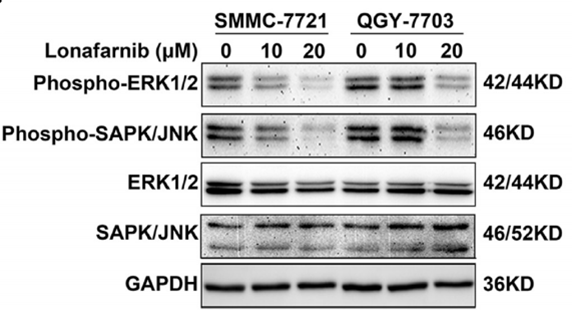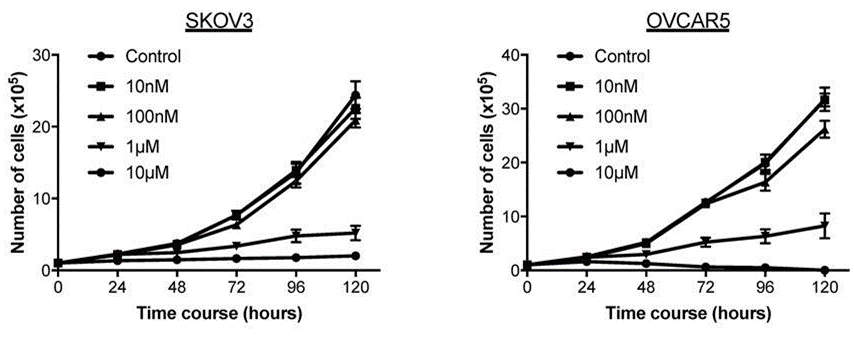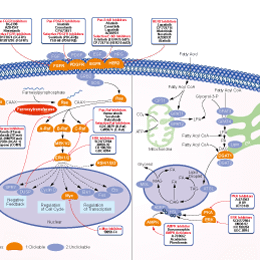
- Bioactive Compounds
- By Signaling Pathways
- PI3K/Akt/mTOR
- Epigenetics
- Methylation
- Immunology & Inflammation
- Protein Tyrosine Kinase
- Angiogenesis
- Apoptosis
- Autophagy
- ER stress & UPR
- JAK/STAT
- MAPK
- Cytoskeletal Signaling
- Cell Cycle
- TGF-beta/Smad
- DNA Damage/DNA Repair
- Compound Libraries
- Popular Compound Libraries
- Customize Library
- Clinical and FDA-approved Related
- Bioactive Compound Libraries
- Inhibitor Related
- Natural Product Related
- Metabolism Related
- Cell Death Related
- By Signaling Pathway
- By Disease
- Anti-infection and Antiviral Related
- Neuronal and Immunology Related
- Fragment and Covalent Related
- FDA-approved Drug Library
- FDA-approved & Passed Phase I Drug Library
- Preclinical/Clinical Compound Library
- Bioactive Compound Library-I
- Bioactive Compound Library-Ⅱ
- Kinase Inhibitor Library
- Express-Pick Library
- Natural Product Library
- Human Endogenous Metabolite Compound Library
- Alkaloid Compound LibraryNew
- Angiogenesis Related compound Library
- Anti-Aging Compound Library
- Anti-alzheimer Disease Compound Library
- Antibiotics compound Library
- Anti-cancer Compound Library
- Anti-cancer Compound Library-Ⅱ
- Anti-cancer Metabolism Compound Library
- Anti-Cardiovascular Disease Compound Library
- Anti-diabetic Compound Library
- Anti-infection Compound Library
- Antioxidant Compound Library
- Anti-parasitic Compound Library
- Antiviral Compound Library
- Apoptosis Compound Library
- Autophagy Compound Library
- Calcium Channel Blocker LibraryNew
- Cambridge Cancer Compound Library
- Carbohydrate Metabolism Compound LibraryNew
- Cell Cycle compound library
- CNS-Penetrant Compound Library
- Covalent Inhibitor Library
- Cytokine Inhibitor LibraryNew
- Cytoskeletal Signaling Pathway Compound Library
- DNA Damage/DNA Repair compound Library
- Drug-like Compound Library
- Endoplasmic Reticulum Stress Compound Library
- Epigenetics Compound Library
- Exosome Secretion Related Compound LibraryNew
- FDA-approved Anticancer Drug LibraryNew
- Ferroptosis Compound Library
- Flavonoid Compound Library
- Fragment Library
- Glutamine Metabolism Compound Library
- Glycolysis Compound Library
- GPCR Compound Library
- Gut Microbial Metabolite Library
- HIF-1 Signaling Pathway Compound Library
- Highly Selective Inhibitor Library
- Histone modification compound library
- HTS Library for Drug Discovery
- Human Hormone Related Compound LibraryNew
- Human Transcription Factor Compound LibraryNew
- Immunology/Inflammation Compound Library
- Inhibitor Library
- Ion Channel Ligand Library
- JAK/STAT compound library
- Lipid Metabolism Compound LibraryNew
- Macrocyclic Compound Library
- MAPK Inhibitor Library
- Medicine Food Homology Compound Library
- Metabolism Compound Library
- Methylation Compound Library
- Mouse Metabolite Compound LibraryNew
- Natural Organic Compound Library
- Neuronal Signaling Compound Library
- NF-κB Signaling Compound Library
- Nucleoside Analogue Library
- Obesity Compound Library
- Oxidative Stress Compound LibraryNew
- Plant Extract Library
- Phenotypic Screening Library
- PI3K/Akt Inhibitor Library
- Protease Inhibitor Library
- Protein-protein Interaction Inhibitor Library
- Pyroptosis Compound Library
- Small Molecule Immuno-Oncology Compound Library
- Mitochondria-Targeted Compound LibraryNew
- Stem Cell Differentiation Compound LibraryNew
- Stem Cell Signaling Compound Library
- Natural Phenol Compound LibraryNew
- Natural Terpenoid Compound LibraryNew
- TGF-beta/Smad compound library
- Traditional Chinese Medicine Library
- Tyrosine Kinase Inhibitor Library
- Ubiquitination Compound Library
-
Cherry Picking
You can personalize your library with chemicals from within Selleck's inventory. Build the right library for your research endeavors by choosing from compounds in all of our available libraries.
Please contact us at [email protected] to customize your library.
You could select:
- Antibodies
- Bioreagents
- qPCR
- 2x SYBR Green qPCR Master Mix
- 2x SYBR Green qPCR Master Mix(Low ROX)
- 2x SYBR Green qPCR Master Mix(High ROX)
- Protein Assay
- Protein A/G Magnetic Beads for IP
- Anti-Flag magnetic beads
- Anti-Flag Affinity Gel
- Anti-Myc magnetic beads
- Anti-HA magnetic beads
- Magnetic Separator
- Poly DYKDDDDK Tag Peptide lyophilized powder
- Protease Inhibitor Cocktail
- Protease Inhibitor Cocktail (EDTA-Free, 100X in DMSO)
- Phosphatase Inhibitor Cocktail (2 Tubes, 100X)
- Cell Biology
- Cell Counting Kit-8 (CCK-8)
- Animal Experiment
- Mouse Direct PCR Kit (For Genotyping)
- New Products
- Contact Us
Lonafarnib (SCH66336)
Lonafarnib (SCH66336) is an orally bioavailable FPTase inhibitor for H-ras, K-ras-4B and N-ras with IC50 of 1.9 nM, 5.2 nM and 2.8 nM in cell-free assays, respectively. Phase 3.

Lonafarnib (SCH66336) Chemical Structure
CAS No. 193275-84-2
Purity & Quality Control
Batch:
Purity:
99.48%
99.48
Lonafarnib (SCH66336) Related Products
| Related Products | Daporinad (FK866) GGTI 298 TFA salt AOA (Aminooxyacetic acid) hemihydrochloride STM2457 Tunicamycin OSMI-4 OSMI-4 A922500 FIDAS-3 SGN-2FF PF-04620110 ERG240 2-BP (2-Bromohexadecanoic acid) OSMI-1 | Click to Expand |
|---|---|---|
| Related Compound Libraries | Metabolism Compound Library Anti-cancer Metabolism Compound Library Glutamine Metabolism Compound Library Carbohydrate Metabolism Compound Library Lipid Metabolism Compound Library | Click to Expand |
Signaling Pathway
Cell Data
| Cell Lines | Assay Type | Concentration | Incubation Time | Formulation | Activity Description | PMID |
|---|---|---|---|---|---|---|
| Cos-1 monkey kidney cells | Function assay | Inhibition of Protein farnesyltransferase in Cos-1 monkey kidney cells expressing H-Ras-val, IC50=0.0019 μM | 12190309 | |||
| COS-7 monkey cells | Function assay | Inhibiting the farnesylation of H-ras proteins in COS-7 monkey cells transiently expressing H-ras[Val12]-CVLS in the whole cell assay, IC50=0.01 μM | 9822558 | |||
| MCF-7 tumor cell line | Growth inhibition assay | Compound was measured for inhibition of MCF-7 tumor cell line in breast under soft agar assay, IC50=0.05 μM | 9822558 | |||
| HCT116 | Growth inhibition assay | Compound was measured for inhibition of HCT116 tumor cell line in colon under soft agar assay, IC50=0.07 μM | 9822558 | |||
| NIH-H tumor cell lines | Growth inhibition assay | Compound ability to inhibit anchorage-independent growth of NIH-H tumor cell lines in soft agar, IC50=0.072 μM | 9822558 | |||
| NIH3T3 cells | Function assay | Inhibition of Ras farnesylation in H-Ras transformed NIH3T3 cells, EC50=0.1 μM | 15454228 | |||
| NIH-K tumor cell lines | Growth inhibition assay | Compound ability to inhibit anchorage-independent growth of NIH-K tumor cell lines in soft agar, IC50=0.5 μM | 9822558 | |||
| Cos-1 | Function assay | Inhibition of Protein farnesyltransferase in Cos-1 monkey kidney cells expressing H-Ras-val, IC50 = 0.0019 μM. | 12190309 | |||
| Cos-1 | Function assay | Effect on Ras processing in Cos-1 monkey kidney cells expressing either H-Ras-Val 12-CVLS or H-Ras-Val12, IC50 = 0.01 μM. | 10411485 | |||
| COS7 | Function assay | Inhibition of FTase in human COS7 cells, IC50 = 0.01 μM. | 20925433 | |||
| H-Ras transformed cells | Function assay | Inhibition of soft agar colony formation in H-Ras transformed cells, IC50 = 0.07 μM. | 15501065 | |||
| NIH3T3 | Function assay | Effective concentration against Ha-RAS processing in NIH3T3 ras-transformed cells, EC50 = 0.16 μM. | 12657284 | |||
| NIH3T3 | Function assay | TP_TRANSPORTER: inhibition of DNR efflux (DNR: ? uM) in MDR1-expressing NIH3T3 cells, IC50 = 2.7 μM. | 11606389 | |||
| A673 | qHTS assay | qHTS of pediatric cancer cell lines to identify multiple opportunities for drug repurposing: Primary screen for A673 cells | 29435139 | |||
| DAOY | qHTS assay | qHTS of pediatric cancer cell lines to identify multiple opportunities for drug repurposing: Primary screen for DAOY cells | 29435139 | |||
| Saos-2 | qHTS assay | qHTS of pediatric cancer cell lines to identify multiple opportunities for drug repurposing: Primary screen for Saos-2 cells | 29435139 | |||
| BT-37 | qHTS assay | qHTS of pediatric cancer cell lines to identify multiple opportunities for drug repurposing: Primary screen for BT-37 cells | 29435139 | |||
| RD | qHTS assay | qHTS of pediatric cancer cell lines to identify multiple opportunities for drug repurposing: Primary screen for RD cells | 29435139 | |||
| BT-12 | qHTS assay | qHTS of pediatric cancer cell lines to identify multiple opportunities for drug repurposing: Primary screen for BT-12 cells | 29435139 | |||
| MG 63 (6-TG R) | qHTS assay | qHTS of pediatric cancer cell lines to identify multiple opportunities for drug repurposing: Primary screen for MG 63 (6-TG R) cells | 29435139 | |||
| NB1643 | qHTS assay | qHTS of pediatric cancer cell lines to identify multiple opportunities for drug repurposing: Primary screen for NB1643 cells | 29435139 | |||
| OHS-50 | qHTS assay | qHTS of pediatric cancer cell lines to identify multiple opportunities for drug repurposing: Primary screen for OHS-50 cells | 29435139 | |||
| Rh41 | qHTS assay | qHTS of pediatric cancer cell lines to identify multiple opportunities for drug repurposing: Primary screen for Rh41 cells | 29435139 | |||
| SJ-GBM2 | qHTS assay | qHTS of pediatric cancer cell lines to identify multiple opportunities for drug repurposing: Primary screen for SJ-GBM2 cells | 29435139 | |||
| SK-N-MC | qHTS assay | qHTS of pediatric cancer cell lines to identify multiple opportunities for drug repurposing: Primary screen for SK-N-MC cells | 29435139 | |||
| NB-EBc1 | qHTS assay | qHTS of pediatric cancer cell lines to identify multiple opportunities for drug repurposing: Primary screen for NB-EBc1 cells | 29435139 | |||
| LAN-5 | qHTS assay | qHTS of pediatric cancer cell lines to identify multiple opportunities for drug repurposing: Primary screen for LAN-5 cells | 29435139 | |||
| Caco-2 | Cytotoxicity assay | 48 hours | Determination of IC50 values for inhibition of SARS-CoV-2 induced cytotoxicity of Caco-2 cells after 48 hours by high content imaging, IC50 = 5.68 μM. | ChEMBL | ||
| Caco-2 | Toxicity assay | 48 hours | Toxicity against Caco-2 cells determined at 48 hours by intracellular ATP concentration using the CellTiter-Glo Luminescent Cell Viability Assay, CC50 = 10.71 μM. | ChEMBL | ||
| Click to View More Cell Line Experimental Data | ||||||
Biological Activity
| Description | Lonafarnib (SCH66336) is an orally bioavailable FPTase inhibitor for H-ras, K-ras-4B and N-ras with IC50 of 1.9 nM, 5.2 nM and 2.8 nM in cell-free assays, respectively. Phase 3. | ||||||
|---|---|---|---|---|---|---|---|
| Targets |
|
| In vitro | ||||
| In vitro | SCH66336 at concentration ranging from 0.1 μM to 8 μM suppress growth and induce apoptosis of human head and neck squamous carcinoma cells (HNSCC) in a dose and time dependent manner. SCH66336 (8 μM) suppresses protein kinase B/Akt activity as well as the phosphorylation of the Akt substrates glycogen synthase kinase (GSK)-3β, forkhead transcription factor, and BAD in SqCC/Y1 cells. [2] SCH66336 demonstrate variable antiproliferative effects against the cell lines, with IC50 ranging from 0.6 μM to 32.3 μM. [3] Lonafarnib induces a CCAAT/enhancer-binding protein homologous protein (CHOP)-dependent transactivation of the DR5 promoter, thus induces CHOP-dependent DR5 up-regulation. Lonafarnib (< 10 μM) activates caspase-8 and its downstream caspases, thus induces caspase-8-dependent apoptosis in H1792 cells. Lonafarnib (5 μM) up-regulate DR5 expression, increase cell-surface DR5 distribution, and enhance tumor necrosis factor-related apoptosis-inducing ligand-induced apoptosis in H1792 cells.[4] | |||
|---|---|---|---|---|
| Cell Research | Cell lines | UMSCC10B, UMSCC14B, UMSCC17B, UMSCC22B, and UMSCC35, UMSCC38 cell lines | ||
| Concentrations | 0.1 μM - 8 μM | |||
| Incubation Time | 24 hours | |||
| Method | The cells are seeded in 96-well cell-culture cluster plates at a density that allowed control cultures to grow exponentially for 5 days. After 24 hours, the cells are treated with different concentrations of SCH66336. SCH66336 is dissolved in DMSO. Control cultures received the same amount of DMSO as the treated cultures do. Cell numbers are estimated after 5 days of treatment by SRB assay. The percentage of growth inhibition is calculated by using the equation: percentage growth inhibition = (1 − At/Ac) × 100, where At and Ac represent the absorbance in treated and control cultures, respectively. The drug concentration causing a 50% cell growth inhibition (IC50), is determined by interpolation from dose-response curves. | |||
| Experimental Result Images | Methods | Biomarkers | Images | PMID |
| Western blot | p-ERK / p-SAPK / p-JNK PARP / cleaved-PARP / pro-caspase3 / cleaved-caspase3 / Bcl-2 Cyclin D / CDK6 / CDK4 / SKP2 LC3A / LC3B |

|
29285232 | |
| Growth inhibition assay | Cell number Cell viability |

|
29069775 | |
| In Vivo | ||
| In vivo | SCH66336 inhibits HTBI77 human lung carcinoma xenograft growth in nude mice in a dose-dependent fashion. [1] SCH66336 dosed at 50 mg/kg p.o. bid by oral gavage inhibits tumor growth with up to 69% growth inhibition after 21 days of treatment in NOD/SCID mice bearing s.c. flank XEN01, XEN05 or XEN08 GBM xenografts. [3] | |
|---|---|---|
| Animal Research | Animal Models | NOD/SCID mice between 6–12 weeks of age |
| Dosages | 50 mg/kg | |
| Administration | p.o. bid by oral gavage | |
| NCT Number | Recruitment | Conditions | Sponsor/Collaborators | Start Date | Phases |
|---|---|---|---|---|---|
| NCT05953545 | Not yet recruiting | Chronic Hepatitis Delta |
National Institute of Diabetes and Digestive and Kidney Diseases (NIDDK)|National Institutes of Health Clinical Center (CC) |
May 15 2024 | Phase 2 |
| NCT02579044 | Enrolling by invitation | Progeria |
Boston Children''s Hospital |
December 2015 | Phase 1|Phase 2 |
| NCT02430181 | Completed | Chronic Hepatitis D Infection |
Eiger BioPharmaceuticals |
November 2014 | Phase 2 |
| NCT01495585 | Completed | Hepatitis D |
National Institute of Diabetes and Digestive and Kidney Diseases (NIDDK)|National Institutes of Health Clinical Center (CC) |
December 2011 | Phase 2 |
| NCT01232881 | Terminated | Breast Cancer |
Hoosier Cancer Research Network|United States Department of Defense|Indiana University School of Medicine|Emory University |
August 2009 | -- |
| NCT00916747 | Active not recruiting | Progeria |
Boston Children''s Hospital|Schering-Plough|Merck Sharp & Dohme LLC|Eiger BioPharmaceuticals |
August 2009 | Phase 2 |
Chemical Information & Solubility
| Molecular Weight | 638.82 | Formula | C27H31Br2ClN4O2 |
| CAS No. | 193275-84-2 | SDF | Download Lonafarnib (SCH66336) SDF |
| Smiles | C1CN(CCC1CC(=O)N2CCC(CC2)C3C4=C(CCC5=C3N=CC(=C5)Br)C=C(C=C4Br)Cl)C(=O)N | ||
| Storage (From the date of receipt) | |||
|
In vitro |
DMSO : 127 mg/mL ( (198.8 mM) Moisture-absorbing DMSO reduces solubility. Please use fresh DMSO.) Ethanol : 127 mg/mL Water : Insoluble |
Molecular Weight Calculator |
|
In vivo Add solvents to the product individually and in order. |
In vivo Formulation Calculator |
||||
Preparing Stock Solutions
Molarity Calculator
In vivo Formulation Calculator (Clear solution)
Step 1: Enter information below (Recommended: An additional animal making an allowance for loss during the experiment)
mg/kg
g
μL
Step 2: Enter the in vivo formulation (This is only the calculator, not formulation. Please contact us first if there is no in vivo formulation at the solubility Section.)
% DMSO
%
% Tween 80
% ddH2O
%DMSO
%
Calculation results:
Working concentration: mg/ml;
Method for preparing DMSO master liquid: mg drug pre-dissolved in μL DMSO ( Master liquid concentration mg/mL, Please contact us first if the concentration exceeds the DMSO solubility of the batch of drug. )
Method for preparing in vivo formulation: Take μL DMSO master liquid, next addμL PEG300, mix and clarify, next addμL Tween 80, mix and clarify, next add μL ddH2O, mix and clarify.
Method for preparing in vivo formulation: Take μL DMSO master liquid, next add μL Corn oil, mix and clarify.
Note: 1. Please make sure the liquid is clear before adding the next solvent.
2. Be sure to add the solvent(s) in order. You must ensure that the solution obtained, in the previous addition, is a clear solution before proceeding to add the next solvent. Physical methods such
as vortex, ultrasound or hot water bath can be used to aid dissolving.
Tech Support
Answers to questions you may have can be found in the inhibitor handling instructions. Topics include how to prepare stock solutions, how to store inhibitors, and issues that need special attention for cell-based assays and animal experiments.
Tel: +1-832-582-8158 Ext:3
If you have any other enquiries, please leave a message.
* Indicates a Required Field
Tags: buy Lonafarnib (SCH66336) | Lonafarnib (SCH66336) supplier | purchase Lonafarnib (SCH66336) | Lonafarnib (SCH66336) cost | Lonafarnib (SCH66336) manufacturer | order Lonafarnib (SCH66336) | Lonafarnib (SCH66336) distributor







































